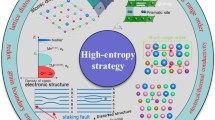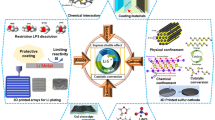General systems theory is used to break down electrically conducting carbon composites (ECCs) and gas-diffusion substrates (GDTs) in fuel cells as objects for systems design. An information model is proposed for systems design and several general laws are discovered to describe the development ECCs and GDTs as part of their complete lifecycle. Methods are found to optimize systems design technology. Systems design and information modeling are shown to be effective tools for the development of ECCs, including nanocomposites with pre-assigned properties.



Similar content being viewed by others
References
Kim Hyunwoo, Ahmed A. Abdala, and Christopher W. Macosko, Graphene/Polymer Nanocomposites, No. 43, 6515-6530 (2010). http://www.nano.umn.edu/conference2010/Nano_Conf_2010_Talk_Macosko.pdf
A new way to make carbon fiber. http://newenergyandfuel.com/2010/06/14/a-new-way-to-make-carbon-fiber/
Graphene-based materials as successors to carbon fiber for lightweight aircraft and vehicles. - http://www.greencarcongress.com/2010/06/graphene-20100609.html
V. E. Gul’ and L. Z. Shenfil’, Electrically Conductor Polymer Composites [in Russian], Khimiya, Moscow (1984).
Min Kyoon Shin, Jiyoung Oh, et al., Adv. Materials., No. 22, 2663-2667 (2010) - http://nanotech.utdallas.edu/publications/documents/Elastomeric ConductiveCompositesBasedonCarbonNanotubeForests.pdf
V. A. Lysenko, Khim. Volokna, No. 3, 44-50 (2008).
V. A. Lysenko, Dizain. Materialy. Tekhnologiya, No. 3 (6), 42-48 (2008).
V. A. Lysenko, “Current trends in the design of gas-diffusion substrates for fuel cells,” Int. Sci. Conf. in Honor of the 70th Year of the Department of Applied Chemistry and Ecology: “Current Growth Trends in the Chemistry and Engineering of Polymeric Materials” (Nov. 24-26, 2008. St. Petersburg). Summary of Documents. St. Petersburg State University of Technology and Design (2008), pp. 21-22.
V. A. Lysenko, Khim. Volokna, No. 5, 41-43 (2009).
V. A. Lysenko, O. V. Lysenko, et al., “Database for systems design of electrically conducting porous composites and products based on them,” Gov. Database Registr. Certif. No. 2010620156.
V. A. Lysenko, M. I. Korzina, et al, “Systems design of gas-diffusion substrates for fuel cells,” Gov. Computer-Program Registr. Cert. No. 2010611564.
V. A. Lysenko, M. I. Korzina, et al, “Components of the systems design of gas-diffusion substrates for fuel cells,” Gov. Database Registr. Certif. No. 2010620174.
G. Szatkowski, S. Koppen, et al., Integrated Vehicle Health Management Lightning & HIRF Research Activities. - https://c3.nasa.gov/dashlink/static/media/project/IVHMProject ReviewDec.08.pdf
Lighting strike protection for composite structures // High-performance composites. July 2006. - http://www.integument.com/pdf/composites_article.pdf
GOST R ISO/MEK 15288-2005 Information Technology. Systems Engineering. Processes in the Lifecycle of Systems. Standartinform, Moscow (2006).
GOST R ISO/MEK 12207-99 Information Technology. Processes in the Lifecycle of Software. Izd-vo Standartov, Moscow (2000).
V. A. Lysenko, Information Model for Design. XI St. Petersburg Int. Conf. “Regional Informatics - 2008 (RI2008)” Materials Conference. Oct. 22-24, 2008. St. Petersburg Society for Informatics, Computer Technology, and Communication and Control Systems (SPOISU) (2008), p. 289.
V. A. Lysenko, A. A. Lysenko, and P. Yu. Salnikova, “Optimization of the properties of electrically conducting porous carbon fiber substrates for fuel cells,” Int. Sci. Conf. in Honor of the 70th Year of the Department of Applied Chemistry and Ecology: “Current Growth Trends in the Chemistry and Engineering of Polymeric Materials” (Nov. 24-26, 2008, St. Petersburg). Summary of Documents. St. Petersburg State University of Technology and Design (2008), pp. 22-23.
V. A. Lysenko, Dizain. Materialy. Tekhnologiya, No. 4 (7), 26-30 (2008).
K. Ulrich and S. Eppinger, Product Design and Development [Russian translation], (translated by M. Lebedev; editor-in-chief A. Matveev), Vershina, Moscow (2007).
M. Mathia J. Roth, et al., Handbook of Fuel Cells - Fundamentals, Technology and Applications. Vol. 3. Fuel Cell Technology and Applications. Chapter 46. Diffusion Media Materials and Characterization (ed: W. Vielstich, H. A. Gasteihtr, J. Fleming, and A. Lamm). John Wiley & Sons Ltd. (2003), pp. 1-21.
Fuel Cell Technologies Program. -http://www1.eere.energy.gov/hydrogenandfuelcells/durability_group.html.
Hydrogen and Fuel Cell Activities, Progress, and Plans: Report to Congress. - http://www.hydrogen.energy.gov/pdfs/epact_report_sec811.pdf.
K. E. Martin, J. P. Kopasz, and K. W. McMurphy, “Status of Fuel Cells and the Challenges Facing Fuel Cell Technology Today,” ACS Symposium Series; Am. Chem. Soc.: Washington, DC (2010) - http://server.ihim.uran.ru/files/info/2011/bk-2010-1040.pdf
V. A. Lysenko and A. A. Lysenko, “Information modeling of nanocomposites as a tool in systems design,” Proc. Int. Sci.-Tech. Conf. “Nanotechnologies of Functional Materials,” Sept. 22-24, 2010. St. Petersburg: Izd-vo Politekhn. Un-ta (2010), pp. 583-585.
Composite Standards. http://www.astm.org/Standards/composite-standards.html
V. A. Lysenko, A. A. Lysenko, and P. Yu. Sal’nikova, Izv. Vyssh. Uchebn. Zaved. Tekhnol. Leg. Prom-sti, 12, No. 2, 10-13 (2011).
V. V. Pavlov, Structural Modeling in CALS-Technologies [in Russian], Nauka, Moscow (2006).
Shanshan Zhao and Zongbin Li, Formalized Reasoning Method for Assembly Sequences Based on Polychromatic Set Theory. - http://resources.metapress.com/pdf-preview.axd?code=ull783w7132219n6&size=largest
Pengfei Zhao, Yi Zhang, et al., A New Formal method of Anticorrosion Design. - http://www.scientific.net/ AMM.44-47.1449.
S. V. Mikoni, Multicriterion Selection from a Finite Set of Alternatives: Manual [in Russian], St. Petersburg Izd. “Lan’” (2009).
Axiomatic Design. - http://www.axiomaticdesign.com/technology/default.asp
Application of Axiomatic Design Starts Microcellular Polymer Industry. - http://www.axiomaticdesign.com/clients/success.asp
B. Gumus, Model of the Axiomatic Design of a Product LIfecycle. Doct. Diss., Texas Technological University. Lubbock, Texas, U.S. (2005) - http://etd.lib.ttu.edu/theses/available/etd-11282005-154139/unrestricted/Gumus_Bulent_Diss.pdf
A. T. Kynin and V. A. Lysenko, Dizain. Materialy. Tekhnologiya, No. 3 (18), 57-64 (2011).
Theory for the Solution of Problems in Inventing (Internet resource) - http:www.ict-systems.ru/events/htm
Resources for Creativity - http://kolesnik.ru/creative-machines/
Creative and Analytical Methods of Developing Innovations - http://www.inventech.ru/pub/guide/
Kang Young Ju., “Improving the design of a polymeric insulator (using the example of the combined use of a TRIZ and the method of axiomatic design) Young Ju Kang, A. Skuratovich, et al. // ETRIA “TRIZ Future Conference, 2004.” Nov. 3-5, 2004, Florence - http://www.trizland.ru/trizba/pdf-articles/LGcable-journal.pdf.
V. A. Lysenko, A. A. Lysenko, et al, “System engineering of porous electrodes,” XII St. Petersburg Int. Conf. “Regional Informatics - 2010 (RI-2010)” Oct. 22-24, 2010. Materials Conference. St. Petersburg Society for Informatics, Computer Technology, and Communication and Control Systems (SPOISU) (2010), p. 335.
V. A. Lysenko, A. A. Lysenko, et al., Ibid., p. 325.
A. Yu. Kuznetsov, T. A. Anan’eva, et al., Ibid., p. 322.
V. A. Lysenko, A. A. Lysenko, et al., Dizain. Materialy. Tekhnologiya, No. 4 (7), 35-38 (2008).
Author information
Authors and Affiliations
Additional information
Translated from Khimicheskie Volokna, No. 1, pp. 31-40, January-February, 2012.
Rights and permissions
About this article
Cite this article
Lysenko, V.A. Electrically conducting carbon composites: systems design and information modeling. Fibre Chem 44, 35–45 (2012). https://doi.org/10.1007/s10692-012-9394-8
Published:
Issue Date:
DOI: https://doi.org/10.1007/s10692-012-9394-8




